Brigadier Stella Bywaters - the 'Salvo Lioness' of Uganda
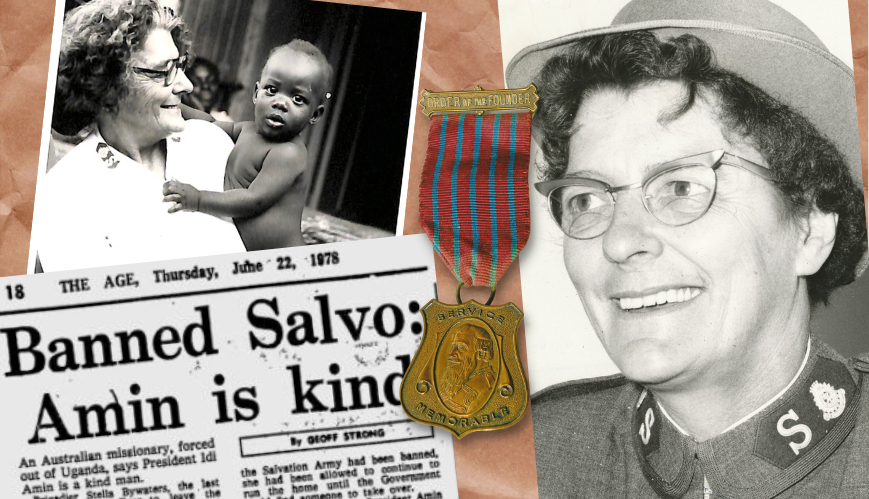
Brigadier Stella Bywaters - the 'Salvo Lioness' of Uganda
Brigadier Stella Bywaters was revered – and feared by a dictator – for her work in Uganda and Kenya, where she was appointed as a Salvation Army officer for 29 years. She received an Order of the Founder for her service in 1978, and even upon retiring in the 1980s stayed in Uganda to act as matron at a children’s home. Pictures est. 1975. Newspaper article from The Age, 22 June 1978.
When Brigadier Stella Bywaters (OF) was promoted to glory on 19 June 2009, the 89-year-old Salvation Army officer was already recognised as a global symbol of compassion and perseverance.
Labelled a ‘Salvo Lioness’ in her feature-length obituary by Torrance Mendez in the West Australian newspaper, in the public’s mind, she stood toe-to-toe with brutal Ugandan dictator Idi Amin when he expelled 27 Christian expressions from Uganda in 1977. He famously said, “I would rather face a lion than Brigadier Stella Bywaters.” But long before she was at the forefront of this persecution, she was already committed to the Lord’s work.
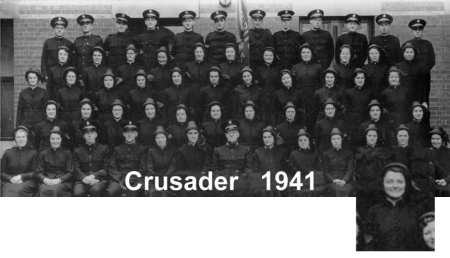 Stella (inset) was part of the Crusader session of Salvation Army cadets.
Stella (inset) was part of the Crusader session of Salvation Army cadets.
Born in Nhill, Victoria, in 1919 to Herbert and Emily Bywaters, Stella was one of six children, all of whom became Salvation Army officers. She was commissioned in 1942 as a member of the Crusader session of cadets (pictured right) alongside her brother Ronald and his wife, Amy. After appointments in Balaclava (Vic), Scottsdale (Tas) and Box Hill (Vic), she was then appointed to Seaforth Boys Home in Gosnells (WA) and praised for her enthusiasm and interest in the young people. Appointed to Friendship House, Uganda, in 1953 and making a permanent move in 1962, she said goodbye to Australian shores in what would become a life-long commitment to love and live between two countries.
Sharing her farewell service from Gosnells with Salvationists Senior Captain and Mrs Bryant, they spoke about their new appointments, and an article in The Coastal District Star stated, “[they] assured the congregation that they go in God’s strength and to do His work, where it may”.
Life in Uganda
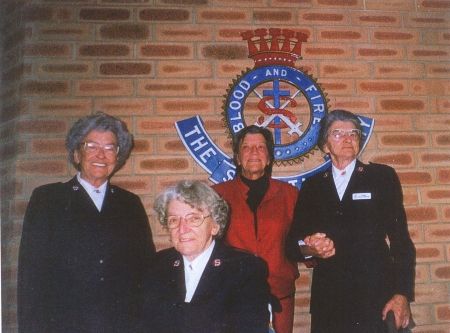 Stella was one of six children who all became Salvation Army officers. Pictured here in the 1990s, Stella (left) with her sisters Gwendolyn, Coral and Marjorie.
Stella was one of six children who all became Salvation Army officers. Pictured here in the 1990s, Stella (left) with her sisters Gwendolyn, Coral and Marjorie.
Upon moving to Uganda, Stella’s rapport with the community was so great that in 1964 she opened the Home of Joy Orphanage in Kampala. She also spent time in Kenya during the Mau Mau uprisings and massacres of the early 1970s. In Uganda, she would serve and eventually preside over two sites supporting abandoned children and people of all ages who were crippled.
Once, when interviewed by the Australian Women’s Weekly at the Army’s Australian centenary celebrations in 1980, she defined her work as running “from sunrise in life to sunset”. A statement that she lived both literally and metaphorically until she was laid to rest in Armadale (WA) some 29 years later.
Her work in Uganda, which took place over nearly three decades, earned Stella an Order of the Founder in 1978. But it wasn’t her actions that initially made the world take notice. She was in the right place at the right time – that is, the last representative of The Salvation Army in Uganda during the reign of military leader and President Idi Amin when he banned 27 mainly protestant organisations in September of 1977.
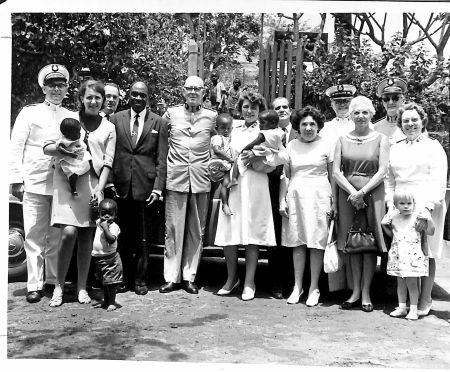 International leadership would visit Brigadier Stella Bywaters and the team at Home of Joy Orphanage in Kampala before 1977. She is pictured here (centre, holding children) next to General Clarence Wiseman. As the most senior Salvation Army officer on site, she was the last representative of The Salvation Army to remain in Kampala to care for abandoned children before being ordered to leave in early June 1978 once the government found someone to take over the work.
International leadership would visit Brigadier Stella Bywaters and the team at Home of Joy Orphanage in Kampala before 1977. She is pictured here (centre, holding children) next to General Clarence Wiseman. As the most senior Salvation Army officer on site, she was the last representative of The Salvation Army to remain in Kampala to care for abandoned children before being ordered to leave in early June 1978 once the government found someone to take over the work.
In a conversation with the New York Times, she shone a light on how The Salvation Army was affected immediately after the announcement was made on the radio. She even contacted the permanent secretary at the Ministry of Religious Affairs, who was in the dark as much as the Army.
“We are not wearing our uniforms, and we have closed our citadels. We hope we shall be allowed to continue with our social work here,” she said. “Nobody has come near us so far. I’ve been here since 1962. This is my home. Our work has even had the support of the President, who has visited us and been appreciative of what we are doing.” She even insinuated that “Amin is kind.”
Toe-to-toe with Amin
As history tells us, President Amin was a dictator who seized control of the country with the help of colonial powers and ruled from 1971 to 1979. His choice to ban 27 religious organisations in 1977 was just one of many actions that persecuted people of different ethnicities, faiths and abilities.
 Despite civil unrest, The Salvation Army flourished in Uganda after its introduction in 1931, culminating in a rich tradition of Salvationists, open-air meetings and social services. Pictured here, Brigadier Stella Bywaters helps unfurl a new flag for an expression in the early 1970s. Due to Amin, international Salvation Army staff were banned and had to leave the country in 1977. In the years following Amin’s fall, Salvation Army officers would return to Uganda and work with the communities to bring restoration, hope and healing.
Despite civil unrest, The Salvation Army flourished in Uganda after its introduction in 1931, culminating in a rich tradition of Salvationists, open-air meetings and social services. Pictured here, Brigadier Stella Bywaters helps unfurl a new flag for an expression in the early 1970s. Due to Amin, international Salvation Army staff were banned and had to leave the country in 1977. In the years following Amin’s fall, Salvation Army officers would return to Uganda and work with the communities to bring restoration, hope and healing.
In his obituary, The Guardian called him “one of the most brutal military dictators to wield power in post-independence Africa”. And with no elections held, and facilitating his rule with secret police, at least 80,000 people were killed during his reign. (The International Commission of Jurists in Geneva allege the figure is closer to 300,000. Amnesty International state the figure is 500,000.)
This was the Uganda that Brigadier Stella Bywaters lived in – although she asserted that she felt safe in her beloved country.
But how did Amin encounter the ‘Salvo Lioness’ before the ban? The year before, Amin had met Stella to discuss the work of The Salvation Army.
“He was just a quietly spoken man who seemed very interested in our work,” she told The Age on 22 June 1978, two weeks after she left the country. “He seemed to appreciate the work we were doing for the people. I was very surprised when our organisation was banned. I am not so bitter about what happened, but I am sorry to leave the Ugandan families I was looking after.”
Interestingly, an interview in 2005 with the ABC suggests another failed attempt at communication with Amin must have occurred before this. Stella shared that the dictator had invited members of religious organisations to Parliament House for tea but stood them up.
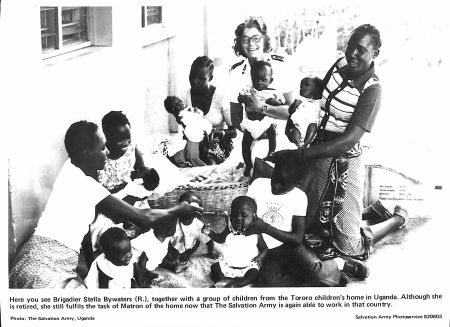 Brigadier Stella Bywaters returned to Uganda even after retiring, serving as Matron at The Salvation Army Tororo Children’s Home.
Brigadier Stella Bywaters returned to Uganda even after retiring, serving as Matron at The Salvation Army Tororo Children’s Home.
“We just sat there and sat there and sat there, but there was no Idi Amin coming.”
This is the instance that formed Stella’s reputation as a ‘Salvo Lioness’. She shared, “Afterward, the expression was that Idi Amin would rather face a lion than face me. He must have been a bit afraid of me because I wasn’t afraid of him, and many, many people were very fearful of him because he was so cruel.”
Indeed the benefit of hindsight and a fallen dictator who could no longer harm the community or the work of The Salvation Army added to the candour of this statement, made only a few years before her death.
Amin was overthrown on 11 April 1979 after Tanzanian troops neared Kampala, allowing Stella and The Salvation Army to return to their work in Uganda the following year. And while she visited Australia for the Army’s centenary celebrations in 1980, Uganda remained her home. Even after retiring, she returned to serve at the Tororo Children’s Home in Uganda.
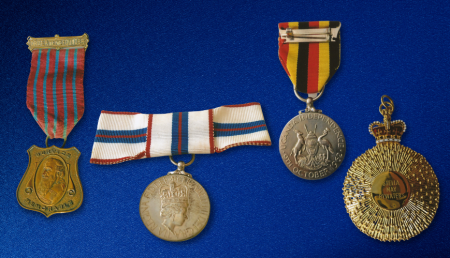 Brigadier Stella Bywaters received The Order of The Founder (far left), The Companion to the Order of Australia, the Uganda Independence Medal and the Queen’s Silver Jubilee Medal.
Brigadier Stella Bywaters received The Order of The Founder (far left), The Companion to the Order of Australia, the Uganda Independence Medal and the Queen’s Silver Jubilee Medal.
A legacy
In 1988, the Australia Southern Territory published Stella’s biography, Star in a Dark Sky: a biography of Brigadier Stella Bywaters, written by Jessie Jenks. And in 2005, she received the Companion of the Order of Australia (AC) for “service to the international community, during an unsafe and dangerous period in Uganda, through the provision of humanitarian aid and nursing care to improve the lives of the sick, poor and dispossessed and to The Salvation Army”.
The then 85-year-old was one of 157 women recognised in the Queen’s Birthday honours list and was one of four awarded the Companion of the Order of Australia Medal. In her lifetime, she was also awarded the Queen’s Silver Jubilee Medal and the Uganda Independence Medal.
Brigadier Stella May Bywaters was promoted to glory on 19 June 2009 while living at Seaforth Gardens, The Salvation Army aged care facility in Gosnells, Western Australia, where her sister and fellow officer Marjorie also lived until her promotion to glory in 2011.
Many thanks to The Salvation Army Museum for its assistance with this article.
Comments
No comments yet - be the first.